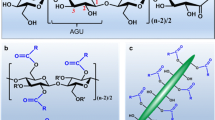Abstract
The main aim of this study was to evaluate the adsorption of aflatoxin B1 by nanocellulose conjugated with retinoic acid (NCRA). First, aflatoxin B1 and NCRA were modeled in the Hyperchem software, and then the adsorption of aflatoxin B1 was simulated by the molecular dynamics technique. Second, nanocellulose was synthesized and conjugated with retinoic acid by cross-linker. Third, the adsorption of aflatoxin B1 and NCRA and its release were evaluated at different conditions. Fourth, its adsorption was evaluated in different foodstuffs. Sixth, its toxicity was evaluated on mouse esophageal cells (MECs). Computer-based simulation showed the adsorption of aflatoxin B1 by NCRA. This study showed that the adsorption and release were less affected by temperature and incubation time but highly affected by pH and concentration. Moreover, it was found that NCRA could adsorb aflatoxin B1 in different foodstuffs. Importantly, NCRA had no remarkable toxicity on the MECs.






Similar content being viewed by others
References
Baek M, Lee J-A, Choi S-J (2012) Toxicological effects of a cationic clay, montmorillonite in vitro and in vivo. Mol Cell Toxicol 8(1):95–101
Denga Y, Szczerbab M (2011) Computational evaluation of bonding between aflatoxin B1 and smectite. Appl Clay Sci 54(1):26–33
Edwards JV, Prevost NT, Condon B, French A (2011) Covalent attachment of lysozyme to cotton/cellulose materials: protein verses solid support activation. Cellulose 18(5):1239–1249
Gauden PA, Terzyk AP, Furmaniak S, Wloch J, Kowalczyk P, Zielinski W (2013) MD simulation of organics adsorption from aqueous solution in carbon slit-like pores. Foundations of the pore blocking effect. J Phys: Condens Matter 26(5):055008. doi:10.1088/0953-8984/26/5/055008
Gnonlonfin GJ, Hell K, Adjovi Y, Fandohan P, Koudande DO, Mensah GA, Sanni A, Brimer L (2013) A review on aflatoxin contamination and its implications in the developing world: a sub-Saharan African perspective. Crit Rev Food Sci Nutr 53(4):349–365. doi:10.1080/10408398.2010.535718
Jebali A, Kazemi B (2013) Nano-based antileishmanial agents: a toxicological study on nanoparticles for future treatment of cutaneous leishmaniasis. Toxicol In Vitro 27(6):1896–1904
Jebali A, Hekmatimoghaddam SH, Behzadi A (2013) Antimicrobial activity of nanocellulose conjugated with allicin and lysozyme. Cellulose 20(6):2897–2907
Madrigal-Santillan E, Morales-Gonzalez JA, Vargas-Mendoza N, Reyes-Ramirez P, Cruz-Jaime S, Sumaya-Martinez T, Perez-Pasten R, Madrigal-Bujaidar E (2010) Antigenotoxic studies of different substances to reduce the DNA damage induced by aflatoxin B(1) and ochratoxin A. Toxins 2(4):738–757. doi:10.3390/toxins2040738
Magnoli AP, Texeira M, Rosa CA, Miazzo RD, Cavaglieri LR, Magnoli CE, Dalcero AM, Chiacchiera SM (2011) Sodium bentonite and monensin under chronic aflatoxicosis in broiler chickens. Poult Sci 90(2):352–357. doi:10.3382/ps.2010-00834
Magnussen A, Parsi MA (2013) Aflatoxins, hepatocellular carcinoma and public health. World J Gastroenterol 19(10):1508–1512. doi:10.3748/wjg.v19.i10.1508
Marroquin-Cardona A, Deng Y, Taylor JF, Hallmark CT, Johnson NM, Phillips TD (2009) In vitro and in vivo characterization of mycotoxin-binding additives used for animal feeds in Mexico. Food Addit Contam Part A Chem Anal Control Expo Risk Assess 26(5):733–743. doi:10.1080/02652030802641872
Mary VS, Theumer MG, Arias SL, Rubinstein HR (2012) Reactive oxygen species sources and biomolecular oxidative damage induced by aflatoxin B1 and fumonisin B1 in rat spleen mononuclear cells. Toxicology 302(2–3):299–307. doi:10.1016/j.tox.2012.08.012
Moudgil V, Redhu D, Dhanda S, Singh J (2013) A review of molecular mechanisms in the development of hepatocellular carcinoma by aflatoxin and hepatitis B and C viruses. J Environ Pathol Toxicol Oncol 32(2):165–175
Natarajan K (1991) Chemical inactivation of aflatoxins in peanut protein ingredients. J Environ Pathol Toxicol Oncol 11(4):217–227
Ortatatli M, Oguz H, Hatipoglu F, Karaman M (2005) Evaluation of pathological changes in broilers during chronic aflatoxin (50 and 100 ppb) and clinoptilolite exposure. Res Vet Sci 78(1):61–68. doi:10.1016/j.rvsc.2004.06.006
Patel VV, Sen DJ, Tyagi S (2013) Correlation between cheminformatics and bioinformatics in drug discovery: a farsight of pharmacy-the millennium oath. J Drug Discov Ther 1(5):47–54
Riccardi E, Wang JC, Liapis AI (2009) The design by molecular dynamics modeling and simulations of porous polymer adsorbent media immobilized on the throughpore surfaces of polymeric monoliths. J Chromatogr Sci 47(6):459–466
Rustom I (1997) Aflatoxin in food and feed: occurrence, legislation and inactivation by physical methods. Food Chem 59(1):57–67
Sheijooni-Fumani N, Hassan J, Yousefi SR (2011) Determination of aflatoxin B1 in cereals by homogeneous liquid–liquid extraction coupled to high performance liquid chromatography-fluorescence detection. J Sep Sci 34(11):1333–1337
Tripathi S, Mishra HN (2009) Studies on the efficacy of physical, chemical and biological aflatoxin B1 detoxification approaches in red chilli powder. Int J Food Saf Nutr Public Health 2(1):69–77
Wang P, Afriyie-Gyawu E, Tang Y, Johnson NM, Xu L, Tang L, Huebner HJ, Ankrah NA, Ofori-Adjei D, Ellis W, Jolly PE, Williams JH, Wang JS, Phillips TD (2008) NovaSil clay intervention in Ghanaians at high risk for aflatoxicosis: II. Reduction in biomarkers of aflatoxin exposure in blood and urine. Food Addit Contam Part A Chem Anal Control Expo Risk Assess 25(5):622–634. doi:10.1080/02652030701598694
Zoghi A, Khosravi-Darani K, Sohrabvandi S (2014) Surface binding of toxins and heavy metals by probiotics. Mini Rev Med Chem 14(1):84–98
Acknowledgments
This article was extracted from the M.Sc thesis of Najme Sedighi and financially supported by the Department of Medical Nanotechnology, Pajoohesh Laboratory, Yazd, Iran. The authors thank the laboratory staff of the Yazd Pajoohesh Medical laboratory.
Conflict of interest
The authors declare no conflict of interest.
Author information
Authors and Affiliations
Corresponding author
Rights and permissions
About this article
Cite this article
Jebali, A., Yasini Ardakani, S.A., Sedighi, N. et al. Nanocellulose conjugated with retinoic acid: its capability to adsorb aflatoxin B1. Cellulose 22, 363–372 (2015). https://doi.org/10.1007/s10570-014-0475-0
Received:
Accepted:
Published:
Issue Date:
DOI: https://doi.org/10.1007/s10570-014-0475-0




